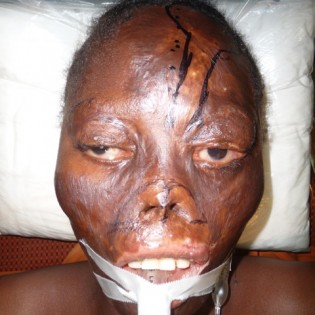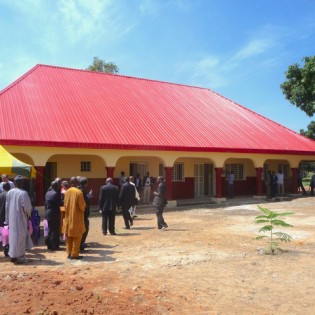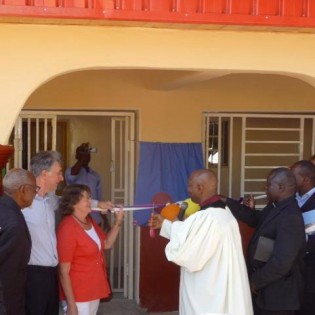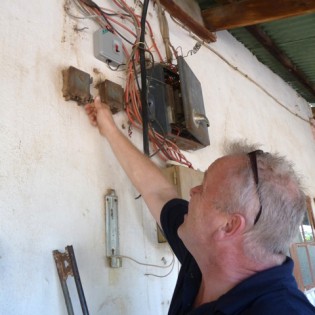Plastic Surgery Camp October 2013 (Nigeria)
Report by Eddy Verschuur
Members of the team:
Plastic surgeon and leader of the team Cees Spronk
Plastic surgeon Eddy Verschuur
Trainee Plastic surgeon Marijn Huijing
Operation assistant Annet Brouwer-Kerssies
Operation assistant Femke Annema
Anaesthesiologist Allard Reijnvaan
Assistant anaesthetist Geke Hoekstra
Technician Rob Verschuur
COCIN Hospital and Rehabilitation Centre, Mangu.
A special mission
The team
Contrary to previous years this was the first mission of this year. Too much disquiet in
Nigeria was the reason to cancel the mission in March so this was the only mission to
Mangu in 2013. The team consisted of the usual delegation of the Medical Centre
Leeuwarden (Cees Spronk, Eddy Verschuur, Annet Brouwer, Femke Annema and Geke
Hoekstra) and trainee plastic surgeon from the UMC Groningen (Marijn Huijing) and a
anaesthesiologist for children from the UMC Utrecht (Allard Reijnvaan). An exceptional
addition was technician-electrician Rob Verschuur. Neeltje Spronk accompanied us for the
Faridpur Foundation.
The hospital
The COCIN Hospital & Rehabilitation Centre is some kilometres outside Mangu city, a relatively small city in Central Nigeria. Cees Spronk, who worked here as a leprosy doctor, made us involved in this hospital. It employs some doctors and physiotherapists and also offers education. On the site there is a rehabilitation centre, a school for the disabled and an obstetric clinic. Special during this mission was that we were allowed to open the new operation theatres. It is no coincidence that the opening was during this mission, as building them was also made possible because of the efforts of the Spronk family and the Faridpur Foundation. With two large operation theatres, a recovery and separate dirty and clean rooms the COCIN Hospital will be up to date for many years to come.
Screening
After our arrival on a Sunday, we started screening the patients on Monday. Cancelling the mission in March had resulted in large numbers of patients. Each time it is special to see how the patients wait patiently to be treated. We saw a great variety of disorders, but the greater part was burn-contractions. Remarkable was the growing number of genital defects, which we cannot account for and which we cannot treat well. In the future we will have to find someone with experience in this field to treat these patients. After having seen the patients and determining the time we need for the operations by the anaesthesiologist, the patients were scheduled for the coming two weeks.
Preparation
We knew that we were to open the new operation theatres, but also knew that we could not operate there yet. All the newly bought equipment was on its way by container, but unfortunately it had not arrived in time in Mangu. Preparing the operations was done in the old and familiar operation theatre. Femke and Geke unpacked the equipment that we brought and Rob started repairing all kinds of broken machines which local electricians could not repair. At the end of the day we had two diathermy-machines working, an anaesthetics machine and…. we had air-conditioning!!
Operating
On Tuesday we started operating. As usual we had to get used to each other and the situation. Especially for Allard it was an exciting day: away from the safe UMC in Utrecht, and now here safely giving anaesthetics with limited means. The extra anaesthetics machines we brought could be used to enhance the safety for both the patient and the anaesthesiologist. The expertise relating to anaesthesiology for children was beneficial for the Nigerian children who are much smaller than West European children.
The atmosphere in the operation theatres was extremely good, also because of the help of local operation assistants. We often made long working days and performed extra operations after the scheduled ones, but nobody complained. The operation days followed each other quickly so that the two weeks also passed quickly, resulting in 98 patients that were operated upon. This year the Faridpur Foundation also supports each patient financially, so that all the patients could be operated upon almost for free.
Non-medical attendance
On previous missions it was clear that the local technicians had insufficient knowledge to maintain the medical equipment. The alterations in the electricity supply are disastrous for the delicate medical equipment. During my previous mission I mentioned that my brother could possibly do some repairing. Having the new operation theatres and the emergency power supply I actually asked Rob to join us and check and repair things.
From the first day local technicians were impressed by the large trunk with tools with which all the machines were repaired. Rob stimulated them to find out why a machine no longer works and helped them to repair it again. Rob’s presence was soon known all over the hospital, resulting in the repair of the autoclave and the ophthalmologists’ operation-microscope. This shows that you do not have to be a medic to do something useful.
Future
Just before the team left the Netherlands the Medical Centre Leeuwarden donated five laptops, which will be used for the school for the disabled in Mangu. Plans for a burns-centre are almost definite. As soon as the new operation theatres will be used, the old complex will be rebuilt into a burns-centre not only for operations, but also for education and prevention. Prevention is the best cure…
Eddy Verschuur
Groningen, December 2013







